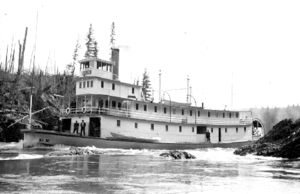Owen Forrester Browne
Owen Forrester Browne was a paddle steamer captain in British Columbia, and Alberta, Canada. He was born in New Westminster and worked on the lower Fraser and Yukon River sternwheelers before coming to the upper Fraser River in the early 1900s.
Owen Forrester Browne | |
|---|---|
 Captain Owen Forrester Browne | |
| Born | |
| Died | 1948 New Westminster, British Columbia |
| Occupation | steamship captain |
| Spouse(s) | Margaret Seymour |
| Parent(s) | Owen W Browne and Teresa Aponi |
Career

Owen Forrester Browne, of Hawaiian heritage, began work on the upper Fraser River in 1906 piloting the pioneer sternwheeler Charlotte. Because of his familiarity with the river and his skill as a swift water pilot the BC Express Company hired him to pilot their first sternwheeler, the BX. Hawaiian pilots were known for their confidence in rough waters and intuitive navigational skills.[1]
Browne skippered the BX for his entire career from May 13, 1910 until August 1919 when she sank in the Cottonwood Canyon carrying 100 tons of sacked cement bound for Soda Creek that had been intended for building the Deep Creek Bridge of the Pacific Great Eastern Railway.[2]

After he left the Fraser, Browne piloted the Northland Echo on the Athabasca River in Alberta.
Family
In 1915, Browne married Margaret Seymour of South Fort George, daughter of the locally famous, Granny Seymour, and they had four sons and five daughters.[3] One of Browne's daughters was named Tito who married Ranford Messer in 1952 and 4 children, 2 sons and 2 daughters. One of Messer's daughters was Colleen Messer, who married Bruce Holbrook and had 2 daughters, Stephanie and Sasha.
Browne's Children include Hugh M. Browne, Betty O'Donnell, Tito Messer, Oni Browne, Blani Olson, William Browne, Earl Browne, Betty O’Donnell and May Thomas, and Leila Johnston.
Browne retired in New Westminster, where he died in 1948.[3]
Browne's mother-in-law Granny Seymour (nee Margaret Boucher) came to be known as the holder of important traditional herbal medicine and Indigenous knowledge[4] and her longevity attracted local and international attention.[5] Seymour's home and notoriety as a midwife was South Fort George, at the northern end of the BX route.
Further reading
- Koppel, Tom (1995). Kanaka:The Untold Story of Hawaiian Pioneers in British Columbia and the Pacific Northwest. Whitecap Books. p. 104. ISBN 1-55110-295-1.
- Downs, Art (1971). Paddlewheels on the Frontier Volume 1. Foremost Publishing. ISBN 0-88826-033-4.
- West, Willis (1985). Stagecoach and Sternwheel Days in the Cariboo and Central BC. Heritage House. ISBN 0-919214-68-1.
- West, Willis (1949). BX and the Rush to Fort George. BC Historical Quarterly.
Notes
- Downs, Art (1971). Paddlewheels on the Frontier Volume 1. Foremost Publishing. pp. 50–52. ISBN 0-88826-033-4.
- West, Willis (1985). Stagecoach and Sternwheel Days in the Cariboo and Central BC. Heritage House. p. 94. ISBN 0-919214-68-1.
- Koppel, Tom (1995). Kanaka:The Untold Story of Hawaiian Pioneers in British Columbia and the Pacific Northwest. Whitecap Books. pp. 103–104. ISBN 1-55110-295-1.
- "Narrative Threads".
- "100+ Iconic Prince George People, Places & Objects - The Exploration Place". www.theexplorationplace.com. Retrieved 2020-03-06.
External links
- Explorasion.org. "Asian North America Timeline Project at UBC". Archived from the original on 2007-07-30. Retrieved 2007-08-03.